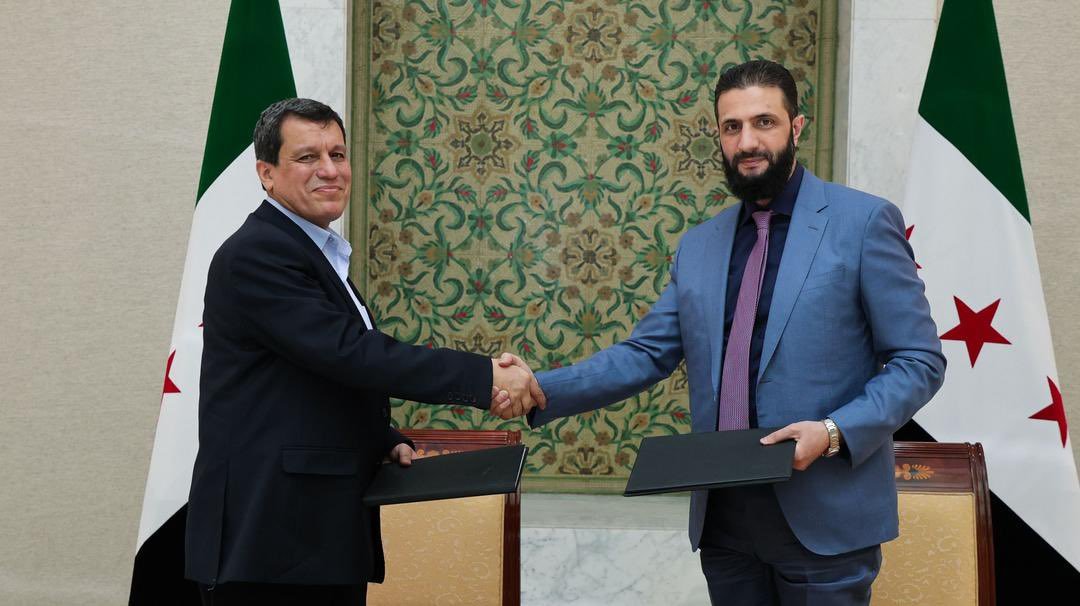Verbal Agreements, No Roadmap: SDF and Damascus Circle the March 10 Deal

The SDF commander Mazloum Abdi has denied in an interview with pro-SDF Rohahi TV that any localised breakthrough has been reached in Deir Ezzor to hand over key assets to the Syrian government. His remarks came just hours after Istanbul-based, Qatari-funded Syria TV claimed there was a verbal agreement to begin gradual integration in Deir Ezzor, including the handover of oil assets and “civilian and military” institutions. Meanwhile, Syrian and Turkish foreign, defence, and intelligence officials met in Ankara yesterday to discuss, among other issues, the SDF file.
Context: Despite the conflicting statements, Abdi described recent talks in Damascus with Ahmad al-Sharaa as “positive,” though he stressed that no concrete agreement had been reached beyond agreeing to continue discussions. He announced that an SDF military committee will soon visit Damascus to address the technical details of how integration should proceed.
On Deir Ezzor and Raqqa, Abdi reiterated that no changes will take place before constitutional reforms are adopted to guarantee the nature of Syria’s governance. He also confirmed that “a military and security understanding” is under discussion and that Washington has proposed forming a joint force between the SDF and the Syrian army to combat ISIS.
Analysis: The Mazloum Abdi interview and the subsequent Syrian–Turkish meeting in Ankara underscore the lack of tangible progress on the March 10 integration framework. Abdi’s comments indicate that talks have not advanced beyond what was already agreed in principle: integration of the SDF into the Syrian army.
The issue isn’t whether to integrate—that principle was codified in writing months ago—but rather the nature of that integration. The recent Abdi-Sharaa meeting, held in the presence of a US envoy, appears to have simply reaffirmed acceptance of integration in principle without addressing the substantive details that have been the sticking point from the start.
Abdi rejected any changes in Deir Ezzor—where the SDF controls the eastern half of the province—or in Raqqa, both predominantly Arab and tribal areas, before constitutional reforms establish a decentralized governance system. Notably, the Deir Ezzor handover claim originated with Syria TV, a Qatari-owned, Istanbul-based channel close to pro-Turkish Syrian factions, not an official state broadcaster. Similar claims of gradual integration starting in Deir Ezzor have circulated since late July.
Syria TV also reported yesterday that the SDF would be integrated into three divisions within the Syrian army, with commandos remaining under SDF leadership and stationed in Hasakah, Raqqa, and Deir Ezzor. This appears unlikely given Abdi’s clear statement that no agreement has been reached and that technical discussions haven’t begun—a delegation will visit Damascus “soon” for serious talks on integration details.
One explanation for the Syria TV reports may be factionalism within Syria’s new regime. Such an arrangement would likely face resistance from the regime’s base, and the framing suggests an attempt to pressure the government. The tension between pro-Turkish elements and HTS, though subtle, is well known.
With the March 10 agreement’s implementation deadline supposedly set for year’s end, Abdi has reason to make positive statements—such as today’s AFP comment about reaching a “preliminary agreement” on integration. But this is the same preliminary agreement codified in March. Given Turkish threats and US pressure, positive messaging is needed to reassure Ankara. Meanwhile, procrastination serves the SDF’s interests by maintaining the status quo while HTS struggles with internal challenges.
The March 10 agreement had an informal implementation window through the end of this year. Against this backdrop, Abdi has reason to issue positive statements, such as his remarks to AFP about a “preliminary agreement” with Damascus. But this is the same preliminary agreement reached months ago.
With Turkish threats and U.S. pressure mounting, such rhetoric is aimed at reassuring Ankara while buying time to maintain the status quo. But this strategy may be a double-edged sword: Turkey has signaled that its patience will run out by year’s end, and al-Sharaa, who favors a negotiated settlement, has hinted that Ankara could take the lead if integration does not materialize.
This could also be a tactical pressure move by al-Sharaa against the SDF. Any Turkish action would depend heavily on Washington’s stance — particularly on whether the U.S. gives a greenlight for drone operations over northeast Syria, which would be central to any Turkish military move.
A settlement remains possible, but the core differences between the SDF and the Syrian government are as wide as they were in March. The disagreement is not merely procedural — it is fundamental: The SDF demands political decentralization, retaining operational control over its forces, even under a new formal structure. However, Damascus insists on administrative decentralization only and the dissolution of independent SDF command structures.
Actions on both sides have widened the gap rather than bridged it. Al-Sharaa recently issued a national holiday decree excluding Newroz, an easy confidence-building gesture that was pointedly missed. Meanwhile, the SDF has hardened control over its areas and further suppressed the teaching of Syrian government curricula in areas under its administration.
While positive statements continue to be issued publicly, tangible progress is lacking, and the two sides appear to be drifting further apart rather than moving toward implementing the March 10 agreement. With Turkey’s deadline looming and Washington’s position uncertain, the months ahead may be decisive in determining whether this stalemate evolves into a settlement — or collapses into confrontation.









